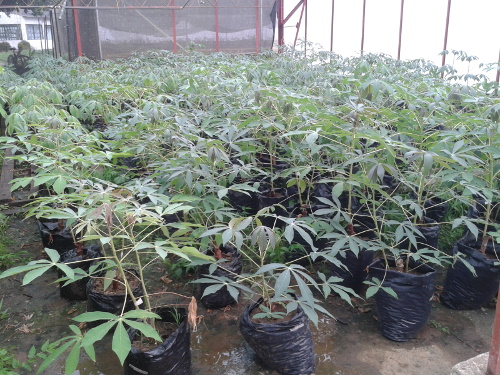Biomass accumulation response of cassava (Manihot esculenta C.) to NPK fertilization and biofertilizers in two soil types under greenhouse conditions

Abstract
The adoption of sustainable technologies that are able to increase profitability in the cassava production systems of the Colombian Caribbean is very limited. The assessment of alternative fertilization practices is required for the development of integrated approaches for crop management. The objective of this research was to estimate how the biomass accumulation response of cassava plants to NPK fertilization is affected by the inoculation of three biofertilizers under greenhouse conditions in two soil types (sandy and clayey loam soils). The selected biofertilizers are commercial products available in the Colombian market: Azobac® (Azotobacter chrococcum), Fosforiz® (Pseudomonas fluorescens) and arbuscular mycorrhizal fungi (Safer Micorrizas®). NPK was applied at varying levels of the recommended nutrients requirements (100, 75, 50, 25 and 0%) in inoculated and non-inoculated (control) treatments in a 2×3×5 factorial design. The highest biomass accumulation was obtained at the lower fertilization levels (25%) in the treatment inoculated with arbuscular mycorrhizal fungi. The cassava plants inoculated with Azobac® and Fosforiz® did not exhibit increased biomass accumulation. Our results suggest that commercial biofertilizers based on mycorrhizal fungi can be used for maximizing cassava responses to NPK fertilization.
Keywords
Plant nutrition, growth promoting bacteria, root vegetables, starch crops, Colombian Caribbean region, sandy soil, clay loam soil
Author Biography
Oscar Burbano-Figueroa
The Plant Interactions Lab
Researcher
References
- Aguilera, M. 2012. La yuca en el Caribe colombiano. De cultivo ancestral a agroindustrial. Economía Regional 158. Banco de la República, Bogotá.
- Begoude, D.A.B., P.S. Sarr, T.L.Y. Mpon, D.A. Owona, M.N. Kapeua y S. Araki. 2016. Composition of arbuscular mycorrhizal fungi associated with cassava (Manihot esculenta Crantz) cultivars as influenced by chemical fertilization and tillage in Cameroon. J. Appl. Biosci. 98, 9270-9283. Doi: 10.4314/jab.v98i1.4
- Cadavid, L.F. 2002. Suelo y fertilización para la yuca. Serie la yuca en el tercer milenio. CIAT, Cali, Colombia. p. 76.
- Carretero, C.L., M. Cantos, J.L. García, R. Azcón y A. Troncoso. 2009. Growth responses of micropropagated cassava clones as affected by Glomus Intraradices colonization. J. Plant Nutr. 32(2), 261-273. Doi: 10.1080/01904160802608601
- Cuesta, I., E. Rengifo y M. Pérez. 2007. Influencia de diferentes dosis de Glomus mosseae sobre plántulas de C. odorata. En: Memorias 4º Congreso Forestal de Cuba. La Habana, Cuba.
- DANE (Departamento Administrativo Nacional de Estadística). 2004. Censo de producción de yuca para uso industrial. Separata de resultados. Bogotá, Colombia.
- Falcón, E. 2010. Efecto de la aplicación de micorrizas arbusculares sobre la producción de posturas de Caoba del país (Swietenia mahagoni L. Jacq.) Homb. Cienc. Tecn. 14, 1-11
- FAO. 2016. Cassava production statistics. En: Faostat,: http://www.fao.org/faostat/es/#data/QC; consulta: enero de 2018.
- Filho, A.C. y M.A. Nogueira. 2007. Microbiota de solo e qualidade ambiental. Instituto Aronómico, Campinas, Brasil.
- Grageda, O.A., A. Díaz, J.J Peña y J.A. Vera. 2012. Impacto de los biofertilizantes en la agricultura. Rev. Mex. Cienc. Agric. 3(6), 1261-1274.
- Heberle, E.D.S., R.D.D. Armas, D.A. Heberle, S.L. Stürmer, L.A.M. Peruch, P.E. Lovato y C.R.F.S. Soares. 2015. Occurrence and structure of arbuscular mycorrhizal fungal communities in cassava after cultivation of cover crops as observed by the “PCR-DGGE” technique. Rev. Bras. Ciênc. Solo 39(5), 1292-1301. Doi: 10.1590/01000683rbcs20140216
- Howeler, R. 2014. Sustainable soil and crop management of cassava in Asia: a reference manual. CIAT Publication No. 389. CIAT, Cali, Colombia.
- João, J.P., A. Ruiz Martínez, L. Simó González y R. Rivera Espinosa. 2016. Efectividad de cepas de HMA en el cultivo de la yuca (Manihot esculenta Crantz) en dos tipos de suelos. Rev. Cult. Trop. 37(1), 48-56.
- Lugtenberg, B. y F. Kamilova. 2009. Plant-growth-promoting rhizobacteria. Annu. Rev. Microbiol. 63, 541-556. Doi: 10.1146/annurev.micro.62.081307.162918
- MADR (Ministerio de Agricultura y Desarrollo rural). 2003. Manejo social del campo 2002-2006. Bogotá, Colombia.
- Molina, L., L. Mahecha y S. Medina. 2005. Importancia del manejo de hongos micorrizógenos en el establecimiento de árboles en sistemas silvopastoriles. Rev. Colomb. Cienc. Pecu. 18(2), 162-175.
- Okon, I.E., M.G. Solomon y O. Osonubi. 2010. The effects of arbuscular mycorrhizal fungal inoculation and mulch of contrasting chemical composition on the yield of cassava under humid tropical conditions. Sci. World J. 10, 505-511. Doi: 10.1100/tsw.2010.59
- Rienzo, J.A., F. Casanoves, M. Balzarini, L. González, M. Tablada y C.W. Robledo. 2015. Infostat. Universidad Nacional de Cordoba, Córdoba, Argentina.
- Sánchez de Praguer, M. 1999. Endomicorrizas en agroecosistemas colombianos. Universidad Nacional de Colombia, Palmira, Colombia. 227 p.
- Séry, D.J.-M., Z.G.C. Kouadjo, B.R.R. Voko y A. Zézé. 2016. Selecting native arbuscular mycorrhizal fungi to promote cassava growth and increase yield under field conditions. Front. Microbiol. 7, 2063. Doi: 10.3389/fmicb.2016.02063
- Straker, C.J., A.J. Hilditch y M.E.C. Rey. 2010. Arbuscular mycorrhizal fungi associated with cassava (Manihot esculenta Crantz) in South Africa. S. Afr. J. Bot. 76(1), 102-111. Doi: 10.1016/j.sajb.2009.09.005
- Suárez, L. y Mederos, V. 2011. Apuntes sobre el cultivo de la yuca (Manihot esculenta Crantz). Tendencias actuales. Cult. Trop. 32(3), 27-35. Doi: 10.3389/fmicb.2016.02063
- Sylvia D.M., J.J. Fuhrmann, P.G. Hartel y D.A. Zuberer. 1999. Principles and applications of soil microbiology. Ed. Prentice Hall Inc, Upper Saddle River, NJ, USA.
- Vessey, J.K. 2003. Plant growth promoting rhizobacteria as biofertilizers. Plant Soil 255, 571-586. Doi: https://doi.org/10.1023/A:102603721689
- Vila, O. 2012. Diagnóstico de la cadena de la yuca en Colombia. Generalidades y situación actual del cultivo de la yuca en Colombia. Ministerio de Agricultura y Desarrollo rural (MADR), Bogotá.
